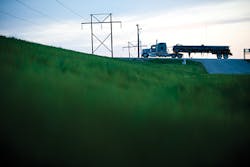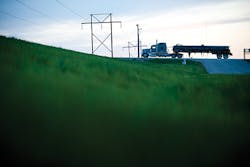Statoil ASA and GE Oil & Gas are seeking outside ideas for their collaborative efforts toward developing sustainable ways, both environmentally and economically, to provide fossil fuels.
During an Apr. 21 briefing at IHS CERAWeek in Houston, executives from the two companies discussed how they have launched a global Open Innovation Challenge, which sought concepts from innovators, institutions, and other companies.
The Open Innovation focused initially on technologies that address the use of sand in unconventional operations. A subsequent phase of the program will focus on water use.
The Statoil-GE collaboration, Powering Collaboration, is an ongoing program to accelerate development of sustainable energy.
That collaboration seeks "an industrial response to some of the biggest challenges facing global oil and gas production."
The two companies decided to include a crowdsourcing program to help reduce the amount of sand trucked to well sites and also to find concepts to develop materials or additives to replace sand.
Bill Maloney, Statoil's executive vice-president of development and production in North America, said trucks make thousands of trips transporting proppant. The trucks cause increased traffic, noise, dust, and exhaust fumes for neighboring communities.
Trucking also represents a significant business cost, Maloney said.
GE Oil & Gas is working with Statoil in efforts to replace or reduce the amount of sand required for hydraulic fracturing.
The goal is to lessen the environmental impact of commercial trucking related to production and to improve operating efficiency for oil and gas companies.
The first phase of the Open Innovation closed Apr. 28. GE Oil & Gas and Statoil plan to use their joint assets to support commercialization of the winning submissions. The winning ideas were scheduled to be announced in June, although no specific date was outlined.
Up to five winners were to be awarded an initial cash price of $25,000 with an additional $375,000 available for development financing. The goal was to select technologies that could reach commercialization within 5 years.
Investing in field technology
Statoil and GE Oil & Gas started their collaboration with efforts by the two companies to reduce flaring, CO2 and methane emissions, and water usage.
One of their best known efforts is Last Mile Fueling, currently being used in the Williston Basin in North Dakota. Executives believe it has potential to reduce the equivalent of 120,000-200,000 tonnes/year of CO2.
Eventually, the technology could be used to replace diesel in field equipment beyond North Dakota, including the gas-rich Marcellus shale, Maloney said.
Lorenzo Simonelli, GE Oil and Gas chief executive officer, told reporters during IHS CERAWeek that relying more on natural gas for vehicle fuel and equipment fuel instead of diesel makes economic sense.
"The key to maximizing value in this price-challenged environment lies in providing cutting-edge solutions quickly, and delivering cost savings and operational efficiency for our customers' existing and future operations," Simonelli said.
In remarks at the Offshore Technology Conference in Houston during May, Simonelli elaborated that industry has an opportunity to "enter a new era in the way it works."
The joint partnership between GE and Statoil aims to reduce emissions from oil and gas production, while also creating efficient and low-cost technologies. Statoil and GE executives say the program will build upon projects already in progress, including:
• Reduce flaring and lower CO2 intensity through innovative application of CNG In A Box as part of the Last Mile Fueling, currently under way in the Bakken formation to provide CNG to fuel trucks and oil field equipment. In Last Mile Fueling, gas that would have been flared in the past is being captured and compressed. The CNG can be used to fuel rigs, trucks, and equipment, thereby reducing or replacing the need for diesel. Gas that Statoil captures but cannot use in its own operations will be compressed and sold.
• Reduce water usage through CO2 stimulation: Use liquefied CO2 stimulation to both reduce water usage in fracturing operations and increase oil and gas production.
• Increase performance, efficiency, and extend maintenance intervals through optimization of gas compressor components.
• Increase performance, and reduce planned and unplanned turbine downtime by cleaning turbines during operation.



